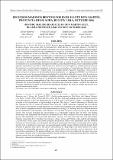Por favor, use este identificador para citar o enlazar este ítem:
https://hdl.handle.net/20.500.12958/5924| Título : | Recursos marinos bentónicos en el islote Don Martín, Provincia de Huaura, Región Lima, octubre 2016 |
| Otros títulos : | Benthic marine resources in Don Martín islet, Huaura Province, Lima Region (October 2016) |
| Autor : | Ramírez, Adrián Ganoza Chozo, Francisco Gonzáles, Rafael Rubio, Juan Alvarez Veliz, Jhon Ramos, Guillermo Neira, Úrsula García, Oscar Barreto Meza, Jesús Resurrección, Juan Suarez, Wilfredo Palma, Henry |
| Palabras clave : | Invertebrados comerciales;Ambiente;Sustratos |
| Fecha de publicación : | dic-2022 |
| Editorial : | Instituto del Mar del Perú |
| Citación : | Ramírez, A., Ganoza, F., Gonzáles, R., Rubio, J., Álvarez, J., Ramos, G., Neira, U., García, O., Barreto, J., Resurrección, J., Suarez, W., Palma, H. (2022). Recursos marinos bentónicos en el islote Don Martín, Provincia de Huaura, Región Lima, octubre 2016. Inf Inst Mar Perú. 49(4): 483-508. |
| Citación : | Informe IMARPE 49(4), 2022; |
| Resumen : | Recursos marinos bentónicos en el islote Don Martín, Provincia de Huaura, Región Lima, octubre 2016. Inf Inst Mar Perú. 49(4): 483-508.- El islote Don Martín (11°01’9,26”S y 77°40´11,03”W) es un importante ámbito biogeográfico, en cuanto a reproducción de especies hidrobiológicas, donde los grupos taxonómicos más representativos son peces y moluscos. El Instituto del Mar del Perú - Imarpe, Laboratorio Costero de Huacho y el Servicio Nacional de Áreas Naturales Protegidas Sernanp - GEFT Guaneras, evaluaron la macrofauna de invertebrados para desarrollar la zonificación. Se tomaron datos de información geográfica, oceanográfica y batilitológica en el islote. Las muestras se recolectaron
manualmente con buceo semiautónomo. Las condiciones encontradas muestran equilibrio entre distribución de especies y densidades; fueron dominantes el caracol negro y concha de abanico. Las biomasas medias son indicativas de una comunidad sin signos de estrés. La macrofauna bentónica estuvo representada por 85 especies, repartidas en seis Phyla, Mollusca fue más abundante con 35 especies. La distribución de recursos de importancia comercial estuvo asociada a fondos duros e intermedios, representados por Thaisella chocolata, Fissurella spp., Octopus mimus y Pattalus mollis y al sustrato blando Argopecten purpuratus, Sinum cymba y Semele corrugata. Los índices de biodiversidad fueron establecidos con el programa PRIMER y se delimitaron los bancos naturales. Se consiguió información batimétrica del relieve del fondo marino y tipo de sustrato en cada zona y se geo-referenciaron imágenes satelitales obtenidas con el programa Google Earth para generar cartas bases. En la zona hay relieves con pendientes inclinadas y playas abiertas de sustrato arenoso. Se registraron parámetros oceanográficos y flujos de corrientes marinas, detectándose un flujo de corriente local
generado por la geomorfología y procesos de refracción como efecto del embate e impacto del oleaje, las corrientes superficiales forman un sistema de recirculación alrededor del islote en sentido anti horario y en sentido horario las de fondo. ABSTRACT: Fish and mollusks are the most representative taxonomic groups in the Don Martín islet (11°01’9.26”S and 77°40’11.03”W), which is an important area in terms of the reproduction of hydrobiological species. The Imarpe Coastal Laboratory of Huacho and the National Service of Natural Protected Areas Sernanp - GEFT Guaneras, evaluated the invertebrate macrofauna to develop the zoning; therefore, we collected oceanographic and bathylithological data on the islet, as well as samples (manually with semi-autonomous diving). Our findings indicate a balance between species distribution and densities, with Thaisella chocolata and Argopecten purpuratus being the dominant species. The average biomasses are characteristic of a community without signs of stress. The benthic macrofauna was represented by 85 species, distributed in six Phyla, Mollusca was more abundant with 35 species. The distribution of commercially important resources was associated with hard and intermediate bottoms, represented by T. chocolata, Fissurella spp., Octopus mimus, and Pattalus mollis, and the soft substrate (A. purpuratus, Sinum cymba, and Semele corrugate). Biodiversity indices were established with the PRIMER software and natural banks were delimited. We obtained bathymetric information on the relief of the seafloor and the type of substrate in each zone and geo-referenced satellite images obtained with the Google Earth software to generate base charts. The area is characterized by steep slopes and open beaches of a sandy substrate. Oceanographic parameters and marine current flows were recorded, and we detected a local current flow generated by the geomorphology and refraction processes as an effect of the impact of waves. The surface currents form a recirculation system around the islet in a counterclockwise direction while the bottom currents flow in a clockwise direction. |
| URI : | https://hdl.handle.net/20.500.12958/5924 |
| ISSN : | 0378-7702 |
| Aparece en las colecciones: | Informe vol. 49(4) 2022 |
Ficheros en este ítem:
| Fichero | Descripción | Tamaño | Formato | |
|---|---|---|---|---|
| Informe 49-4 artículo 1.pdf | 2,79 MB | Adobe PDF |  Visualizar/Abrir |
Este ítem está sujeto a una licencia Creative Commons Licencia Creative Commons

